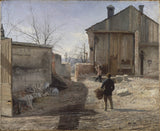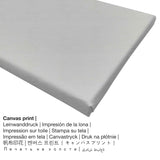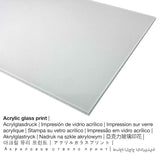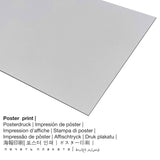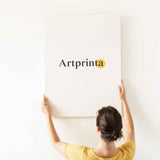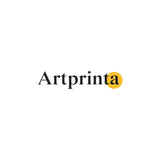Anshelm Schultzberg, 1886 - Na-akwatu Ochie Orphanage, Stockholm - ọmarịcha akwụkwọ nka.
Ụtụ gụnyere. Mbupu gbakọrọ na ndenye ọpụpụ.
Ngwaahịa nka anya nkeonwe gị
a 19th narị afọ onye na-ese ihe sere ọrụ nka Anshelm Schultzberg. Emere izizi ya na nha: Ogologo: 98 cm (38,5 ″); Obosara: 120 cm (47,2 ″) Ekebere: Elu: 117 cm (46 ″); Obosara: 141 cm (55,5 ″); Omimi: 10 cm (3,9 ″). Ọrụ nka a gụnyere na National Museum nke Stockholm nchịkọta nka dijitalụ dị na Stockholm, Obodo Stockholm, Sweden. Ọrụ nka, nke dị na ngalaba ọha Enyere ya site n'ikike nke Nationalmuseum Stockholm & Wikimedia Commons. Akara ngosi nke ihe nka bụ: . Ihe ọzọ bụ, alignment bụ na odida obodo format ma nwee oke nke 1.2: 1, nke pụtara na ogologo bụ 20% ogologo karịa obosara.
Họrọ ihe dị iche iche
The product dropdown list provides you with the chance to pick your prefered size and material. Choose among the following product options now to match your preferences in size and material:
- Mbipụta kanvas: The UV printed canvas material applied on a wooden frame. A canvas makes the special look of three dimensionality. A printed canvas of this artpiece will let you turn your into a large size work of art like you know from art galleries. The great advantage of canvas prints is that they are relatively low in weight. This means, it is quite simple to hang up the Canvas print without additional wall-mounts. Because of thata canvas print is suitable for any type of wall.
- Mpempe akwụkwọ mmado ebipụtara na akwa akwa: The Artprinta poster print is a printed cotton canvas with a slightly rough structure on the surface, that reminds the actual version of the artwork. Please keep in mind, that depending on the size of the poster we add a white margin 2-6cm round about the print motif to facilitate the framing with your custom frame.
- Metal (aluminium debond mbipụta): Aluminium Dibond prints are metal prints with an impressive effect of depth - for a modern look and non-reflective surface.
- Mbipụta iko acrylic (nke nwere ezigbo mkpuchi iko): A glossy acrylic glass print, often named a print on plexiglass, will convert your favorite artwork into amazing home décor and makes a good alternative to canvas or aluminium dibond fine art prints. The real glass coating protects your custom art replica against light and external influences for many years.
Ederede iwu dị mkpa: We try our utmost to describe the products as accurate as possible and to display them visually on the different product detail pages. However, the colors of the printing material and the print result can vary marginally from the representation on the monitor. Depending on the settings of your screen and the nature of the surface, not all colors will be printed as realistically as the digital version shown here. Considering that all the are processed and printed manually, there might as well be slight deviations in the size and exact position of the motif.
Ngwaahịa a
| Nkewa edemede: | nka nka |
| Mmeputakwa: | dijitalụ mmeputakwa |
| Produzọ mmepụta: | UV kpọmkwem obibi |
| Mmalite nke ngwaahịa a: | German mmepụta |
| Stockdị ngwaahịa: | na mmepụta ihe |
| Ihe eji eme atụmatụ: | ụlọ mmepụta ihe nka, ihe ndozi mgbidi |
| Nhazi nka nka: | nhazi odida obodo |
| Ụdị anya: | 1.2:1- (ogologo: obosara) |
| Nsonaazụ: | ogologo bụ 20% ogologo karịa obosara |
| Nhọrọ akụrụngwa: | akwụkwọ mmado (akwụkwọ kwaaji), mbipụta ọla (aluminium dibond), mbipụta iko acrylic (nke nwere ezigbo mkpuchi iko), mbipụta akwụkwọ. |
| Nhọrọ nke akwa akwa n'elu etiti ihe ndọtị (mbipụta akwa akwa): | 60x50cm - 24x20", 120x100cm - 47x39", 180x150cm - 71x59" |
| Mbipụta iko acrylic (nwere ezigbo mkpuchi iko) dị iche iche: | 60x50cm - 24x20", 120x100cm - 47x39", 180x150cm - 71x59" |
| Mpempe akwụkwọ mmado (akwụkwọ kwaaji) nha: | 60x50cm - 24x20", 120x100cm - 47x39" |
| Mpempe akwụkwọ Dibọn (ihe alumnium): | 60x50cm - 24x20", 120x100cm - 47x39" |
| Nhazi mbipụta nka: | adịghị |
Ozi ahaziri na nka
| Aha ọrụ nka: | "Demolishing the Old Orphanage, Stockholm" |
| Nhazi nke ọrụ nka: | sere |
| Category: | nkà nke oge a |
| Time: | 19th narị afọ |
| Emepụtara na: | 1886 |
| Ogologo afọ nka nka: | ihe karịrị 130 afọ |
| Nha ihe osise izizi: | Ogologo: 98 cm (38,5 ″); Obosara: 120 cm (47,2 ″) Ekebere: Elu: 117 cm (46 ″); Obosara: 141 cm (55,5 ″); Omimi: 10 cm (3,9 ″) |
| Ụlọ ihe ngosi nka / ebe: | National Museum nke Stockholm |
| Ebe ebe ngosi nka: | Stockholm, Obodo Stockholm, Sweden |
| ibe weebụ: | www.nationalmuseum.se |
| License: | ngalaba ọha |
| Site n'aka: | Nationalmuseum Stockholm na Wikimedia Commons |
Tebụl nyocha nke onye na-ese ihe
| aha: | Anshelm Schultzberg |
| Ọrụ onye na-ese ihe: | onye na-ese ihe |
| Otu nka: | omenkà nke oge a |
© Nwebiisinka | www.artprinta.com (Artprinta)
Nkọwa ihe osise nke Nationalmuseum Stockholm (© Nwebiisinka - nke Nationalmuseum Stockholm - National Museum nke Stockholm)
English: In his poem ‘The Esplanade System’, from 1883, August Strindberg describes how a modern Stockholm was emerging at that time, with old houses being torn down ‘for light and air’. Schultzberg’s painting s a commentary on the same process. With razor-sharp realism he records the demolition of the old orphanage, meticulously capturing he early spring light, the many nuances of the gravel and rocks, and the clouds of dust. The subject of the painting is the gap left by the building, or rather, the light and air in this empty space. 1880-talet brukar beskrivas som realismens decennium i svensk konst. Många konstnärer arbetade nu med vardagliga motiv som de framställde utan idealisering. Det blev populärt att skildra kroppsarbetande människors tillvaro. Bilder av jordbruksarbetare och fiskare blev vanliga, men också bilder av människor som tillhörde den nya arbetarklassen i städerna. Schultzbergs bild av rivningsarbete i Stockholm är typisk för 1880-talsrealismen. Konstnären har valt ett motiv som knappast kan uppfattas som vackert i traditionell mening. Schultzberg har lagt ned stor möda på att skildra den tidiga vårens skarpa dagsljus, och de fint nyanserade valörerna i grus och stenar och dammet som yr. De svenska konstnärerna mötte den konstnärliga realismen i Paris, dit många unga nordiska konstnärer reste för att studera och arbeta under 1870- och 1880-talen. Schultzberg hade emellertid ännu inte varit i Frankrike då han målade Rivningen av gamla Barnhuset. Han utförde målningen under sitt sista år vid Konstakademien i Stockholm och ställde ut den på akademiens elevutställning 1886. Den franska realismen hade dock redan introducerats i Stockholm, och Schultzberg hade säkert tagit intryck av de svenska realister som visade målningar de utfört i Frankrike på utställningar i Stockholm i mitten av 1880-talet.

